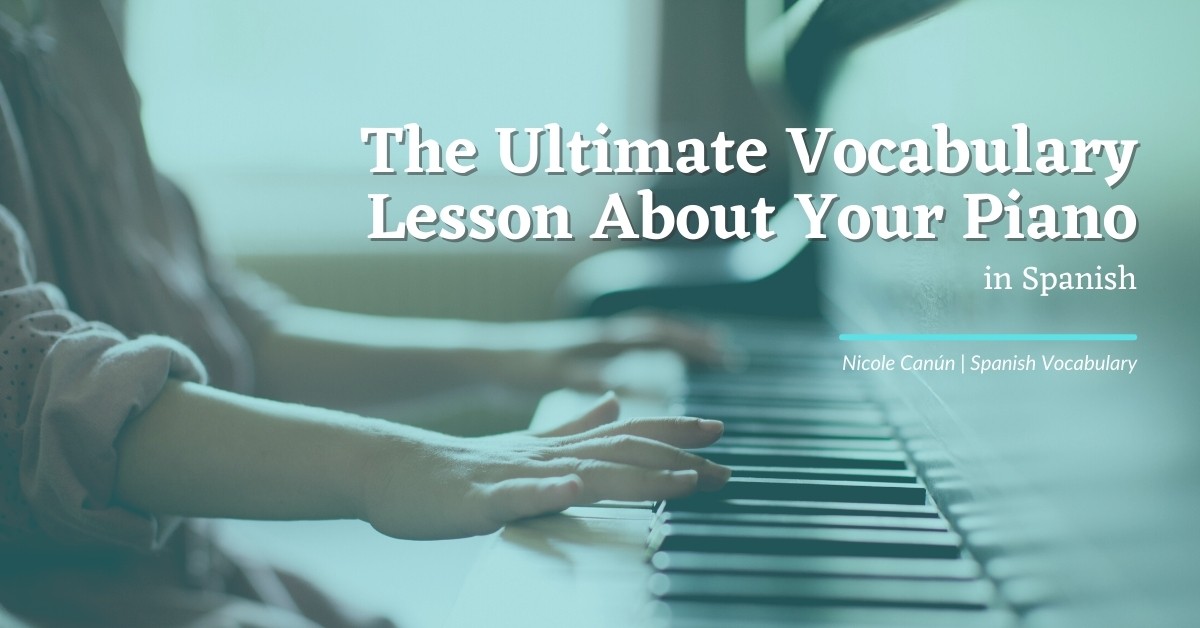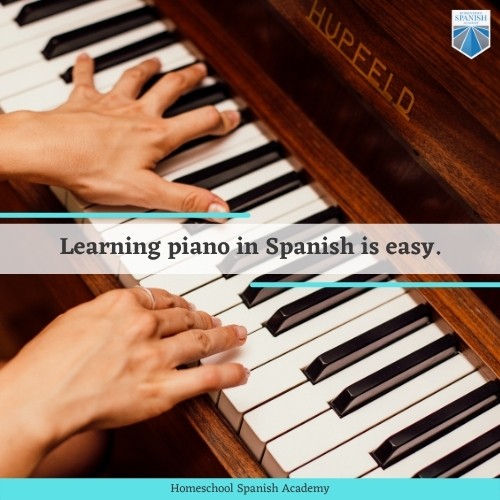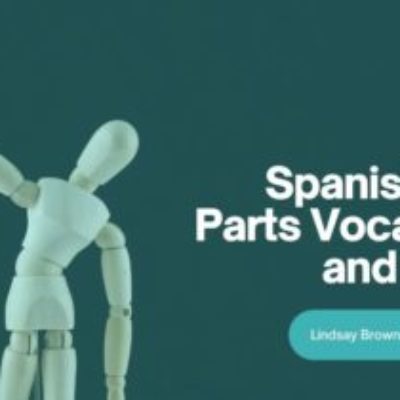
The Ultimate Vocabulary Lesson About Your Piano in Spanish
Are you interested in learning piano in Spanish?
Piano is a beautiful, versatile instrument that happens to be perfect for those with little to no music experience. Short-term reassurance is possible playing piano since you can see results almost immediately.
Beginners can play short melodías or melodies in a matter of days, which is motivating. Master piano terminology while practicing a new language and immerse yourself in two new worlds at the same time!
¡Vamos!
Let’s go!
Piano Dynamics
The piano was invented in 1700 in Italy, so it makes sense that most standard piano terms are in Italian. Its original name, “pianoforte,” means suave y fuerte—soft and loud—and it has to do with the dynamic quality of the instrument. You can go from joy to despair, from feeling triumphant to frightened, from soft to loud in a second.

Piano is a dynamic instrument that lets the performer truly express feelings and change them quickly. Pieces and passages can be unpredictable and surprise the listener from time to time.
Learning piano in Spanish is easy. Some of the terms in this lesson are similar to English words, so it will be effortless to remember them!
Piano
Piano in Spanish can be played tranquilamente (quietly) or suavemente (gently) and it is referred to in a scale with a p. When el compositor (the composer) writes the music to be played extremely softly, it will be indicated with pp or ppp, meaning pianissimo on different levels. The intention of the melodía is to sound calmada and nostálgica—calm and nostalgic.
Forte
The compositor communicates that a section of the song needs to be fuerte (loud, strong, or intense) with an f or fortissimo with ff or fff. The intention is to sound victorious or even alarmed.
Mezzo
Medio or half. With an mp or an mf, the scale tells you to play moderately suave or moderately fuerte.
Subito Piano
Súbito in Spanish and Italian means suddenly. This comes habitually after a loud passage to inject surprise to the melodía.
Crescendo
Notes get gradually louder with creciendo to build up excitement and it is specified with its abbreviation, “cresc.”
Decrescendo
Notes get gradually softer over the course of a pasaje or passage. It can also be called diminuendo. The abbreviations are “decresc.” or “dim.”
Piano Articulation
Now that you know the basics, let’s dive deeper into the jargon and learn more about piano in Spanish. Below are some words you might find useful if you want to be a pianista.
Accompaniment
The notes in the background of a piano main theme is called acompañamiento. It is used to support the whole piece or sections of it. The accompaniment notes in piano are normally played by the left hand in a soft way.
Staccato
Separado means detaching or short, and it is indicated on the scale with dots or puntos above the notes. The composers’ intention is for the musician to make quick defined notas. You need to play the key and quickly remove your finger. The sound is powerful or potente. This section is normally separated from the rest of the passage slightly.
Legato
Ligado is the opposite of staccato. Notes are linked together with a slur or liga above them. It is also called media luna or half moon. They are intended to be played in a smooth way.
Marcato
These are the strokes that are emphasized or marcado. They are marked more than staccato and its abbreviation is “marc.”
Dolce
Dulce or sweet. These sections are meant to be played sweetly and gently.
Leggiero
Ligero or light. The notes should be played delicately or swiftly.
Con Pedale
Con pedal means the pianista should use one of the pedals when playing a melody.
Tempo
Tiempo or timing is the rhythm that gives you stability. By shifting it you change the dynamic of the pasaje. These terms will help you understand terminology of piano in Spanish.
Accelerando
Acelerar, or accelerating the tempo, makes the melody more dramatic, joyful, and exciting. The music draws attention to itself with this insertion. The abbreviation is “accel.” It is also called “stringendo.”
Decelerando
Desacelerar is to slow down the tempo gradually, this gives you a little rest, normally from more accelerated sections.
Ritard
Retardo or delay. This is to aggressively slow down the music and it is usually the end section of the passage so it’s noticeable.
Energico
Piano in Spanish is easy because Italian terms resemble words in Spanish. This example is proof since it is practically identical, it only needs an accent. Enérgico is a term used to indicate that a piece needs to be played in an upbeat, energetic, and enthusiastic way.
Rubato
Robado or stolen. The pianist sets the tempo: slows down, speeds up, goes with the flow or with his or her feelings. Although it isn’t specified in the scale, the performer’s discretion is respected in certain music styles.
Andante
Also andante in Spanish, this is a comfortable and “walkable” moderate-slow speed part of a passage.
Allegro
This is a fast-speed tempo played in a light, energetic way. It means alegre or joyful.
Melody Map
Sometimes, passages or pieces aren’t linear. This means that if you need to repeat parts of it or start from the beginning again, it is better to be told with signs rather than having that section written again. The following translated terms will help you understand piano in Spanish better.
Coda
Cola or tail is the closing of a movement. It resolves the climax, slows down and finishes. It provides a peaceful feeling.
Da Capo
From the head, desde la cabeza, or D.C. This indication means that the performer should go back to the beginning of the pasaje and play everything all over again.
Dc Al Fine
This is from the beginning to the end, del principio al fin. It emphasizes the end with two bars in the scale as you don’t have to go back to any part of the passage. This specific passage is linear and sequential.
Dal Segno
This term means the performer has to repeat a certain section of the melody marked by la señal or the sign, indicated with “D.S.”
More Piano Terminology
Here’s a list of terminology you will find helpful on your way to becoming a piano in Spanish expert!
Opus
Obra, or piece, is the singular form of opera. It is a numbering method to divide the work of a compositor into sections, which makes practicing easier.
Movements
The movimientos are large sections within a single piece, and they are indicated with Roman numerals.
Sonata
This is a piece with multiple movements written for an instrument specifically and played by a solista or soloist.
Concerto
A concierto is an entire piece written to be played with an orchestra or orquesta.
Nocturne
Nocturnos are reflective and melancholic pieces that transmit peace and sound like a nighttime melody.
March
A marcha is an upbeat piece performed at parades or desfiles.
Waltz
This slow or fast ballroom dance was popular centuries ago. It is called vals in Spanish.
Impromptu
This is a section of a passage that can be improvised or improvisado by the performer.
Motif
The motivo is the main musical theme that keeps you listening to a large piece for a long time.
Pentatonic scale
The pentatonic scale is a musical scale or escala musical that has 5 notes or notas.
Homophony
Homophony is when a piece is played or sung at the same time in unísono or unison.
Fermata
This is a discretionary term that lets the performer decide for how long he holds a tone or tono in order to give power to a song.
Fugue
This three- to six-voice composition or composición intends that they all enter at different times creating counterpoints between them. In Spanish, the word is fuga.
Deceptive cadence
The song seems to be moving towards the end but it doesn’t end. This cadencia engañosa is used to avoid predictability and lets the composer extend the song.
Etude
This French piece means study or estudio and it’s made specifically so the musician develops music skills.
Interval
Intervalo is the distance between notes.
Talk About Piano in Spanish!
Don’t let your estudios go to waste. Make your tiempo worth it and bring up your Spanish notas with Homeschool Spanish Academy! Converse with a native Spanish-speaking teacher to secure your knowledge. Join our 24,000 monthly active students and learn from our friendly teachers from Guatemala. Sign up today for a free trial class to keep practicing your newly learned terminology related to piano in Spanish!

Ready to learn more Spanish vocabulary? Check these out!
- Earth Day Projects for Kids + Spanish Earth Day Vocabulary
- How to Talk About the Temperature in Spanish: Fahrenheit, Celcius, and Descriptions
- Car Parts Spanish Vocabulary List: Learn Using Pictures
- Top 15 New Year’s Resolutions in Spanish
- Talk About Hurricanes And The Weather in Spanish
- Spanish Words with Multiple Meanings in Latin America
- World Mental Health Day: A Vocabulary Guide for Mental Health Workers
- Expressing Appreciation in Spanish on World Teachers’ Day
- Car Parts Spanish Vocabulary List: Learn Using Pictures - February 1, 2024
- Discovering The Mayan Languages - January 4, 2024
- The 10 Most Common Spanish Surnames in The U.S - December 28, 2023




